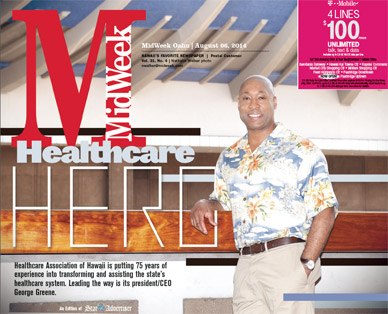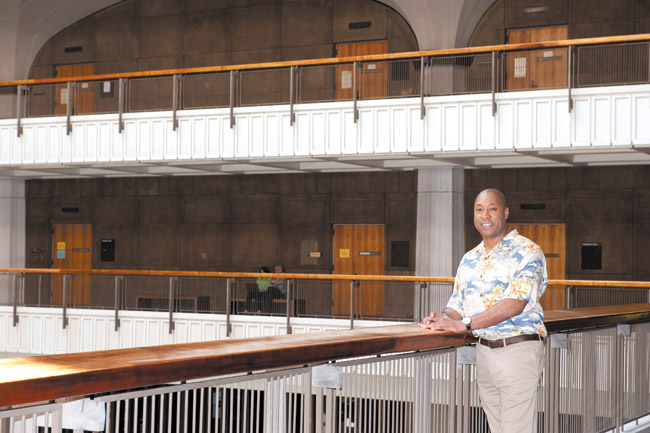Healthcare Hero
Healthcare Association of Hawaii is putting 75 years of experience into transforming and assisting the state’s healthcare system.
As a soccer player, George Greene knows the importance of keeping his eye on the ball. This ability plays an even bigger role in his profession. As president and chief executive officer of Healthcare Association of Hawaii (HAH), his actions impact major players in the medical and caregiving fields.
Hospitals, clinics, nursing facilities and suppliers comprise a highly regulated industry. As healthcare goes through revolutionary reform — to continue the analogy — there are so many balls in the air even the spectators are confused.
mw-cover-080614-georgegreene-1
It’s Greene’s job in Hawaii to calm the jitters and focus on the playbook of strategies in healthcare that score victories for both patients and providers.
Greene and his organization advocate for policies in the industry that ultimately affect our well-being and pocketbook. Founded in 1939, it represents 75 years of healthcare advocacy in the state.
Yet the organization’s mission, accomplishments and platforms are not as apparent to the public as they are to its 138 members of providers, stakeholders and policy makers. We wanted a look at its playbook of healthcare reform to see how it scores on quality-care standards and compliance.
To do that, we meet Greene at the State Capitol, where he spends a lot of time as the voice — OK, lobbyist — for HAH. Love the acronym.
Greene provides illuminating insights into the triumphs and challenges of providers who are experiencing unprecedented change and controls.
Asked to describe the current picture, Greene calls it “an interesting time.”
That’s putting it mildly.
The current debate regarding reform includes questions of the right to healthcare, access, fairness, sustainability, quality and government spending. The public-private health-care system in the United States is said to be the most expensive in the world, yet it lags in optimal-care standards.
“The healthcare sector will continue to be challenged by significant environmental shifts, continuing reimbursement pressures and ongoing implementation of burdensome and costly regulations,” Greene says. “The principal drivers of healthcare reform — the recently enacted Patient Protection and Affordable Care Act — require improved connections and synergy between HAH and the public.”
In other words, things will be hemajang if providers, patients and policy makers don’t make things pono.
You think costs are bad now? Aging populations and technological advances will cause healthcare costs to continue to rise and will have a widespread impact on health-care spending, design of national systems and delivery, according to Harvard Business Review.
(And it’s not true that we are living longer to have extra time to pay our medical bills!)
Among HAH’s members are acute care hospitals such as Straub, Castle and Kapiolani; long-term care facilities, Medicare-certified home health agencies, hospice programs, as well as durable medical equipment suppliers, air and ground ambulance, blood banks and respiratory therapy providers.
HAH calls it “the continuum of care” across our state.
While providers are focused on patient care, HAH is focused on policy.
Fortunately, Greene comes with credentials and experience in policy making. It is his passion.
The 44-year-old health care advocate studied law at University of Tennessee, worked in Washington, D.C., for U.S. Rep. Bob Inglis of his homestate South Carolina, and did policy work for National Association of Homebuilders.
“I liked policy work more than legal work,” Greene admits. “I enjoyed engaging thought leaders and staff on Capitol Hill to effect change.”
Later he worked for San Diego Mayor Susan Golding, San Diego’s Sharp Healthcare system, and American Hospital Association’s western regional division that includes Hawaii.
When HAH’s previous CEO Rich Meiers retired in 2009, Greene was hired, becoming the youngest state association administrator and only person of color in that role.
Despite waves of unprecedented change in healthcare, Greene faithfully has facilitated government-relations efforts to bring federal dollars to Hawaii, streamline systems, encourage best practices among facilities and eliminate conflicts between state and federal regulation.
HAH leverages more than $45 million a year in direct monetary benefit for members, including $31 million in federal funds through nursing facilities and hospital sustainability programs, drastically improving Medicaid reimbursement rates, according to Greene.
Public-policy administering is especially valuable to smaller operators and employers who do not have the staff to monitor constantly changing regulations.
Greene asserts, “Challenging times allow us to identify and maximize opportunities. Even though we are asking industry to do more (regulations) with less (reimbursements), at the end of the day it results in quality care for patients, more access to care, and causes the system to operate more efficiently.”
Visibility and accessibility on both Capitol Hill and at Hawaii’s State Capitol keep Greene jet-setting and hopping. He’s on a plane at least once a month. Any bids for his frequent-flier miles?
But it’s the mileage he puts into driving home the views of healthcare stakeholders that really counts. Advocacy is said to be the ultimate art of diplomacy, persuasion and enlightenment. Collaboration and compromise are both strategies and tactics in the policy-making game. To bring widely divergent views together for a win-win outcome is the holy grail.
On that front, HAH can be pleased with its score card for this year’s legislative session.
Eight bills from HAH’s legislative package passed and were signed into law. They cover hospitality sustainability (HB2293), nursing facility sustainability (SB2057), home care licensing (HB2094) and mental health discharge (HB1723). There is also, emergency management (HB849), telehealth (SB2469), provider orders for life-sustaining treatment (HB2052) and advanced practice registered nurses (SB2491).
For the 2015 legislative session, HAH will continue its focus on hospital and nursing facility sustainability, regulations for durable medical equipment vendors, worker-protection measures, physician liability and other priorities determined by members.
Greene knows HAH’s members are on the front line of patient interaction, care giving, resource management, emergency and disaster preparedness, and future needs.
“Reimbursement models and quality matrix are forcing acute-care settings (hospitals) and post-acute care (nursing homes, rehabilitation facilities) to work closely because of shared compensation as a result of new federal law,” Greene points out.
This also supports the move to integrated medicine that has transformed the traditional treating-symptoms model to an evidence-based practice of holistic wellness.
OK, we know that’s a lot of sophisticated concepts, but the continuum of care in the medical field has its own language and idioms these days.
It’s not only a matter of educating the general public, Greene proclaims.
“The adage is that Washington is run by a bunch of 20-somethings,” he says of young congressional staffers (average age 21). “They’re smart, but what often emerges in political think tanks sounds good in theory but doesn’t work in practice.”
Greene is one of the credible voices of healthcare called upon by congressional and legislative staffers to give them a dose of reality.
“We educate legislators and act as a sounding board when lawmakers have ideas. At the end of the day, it’s about patients and the front-line staff in the trenches,” Greene says, while adding, “and tangentially the families that surround them.”
To bring that fact to life, HAH annually recognizes “Healthcare Heroes” who exemplify the dedication and extraordinary efforts of medical professionals. It is particularly significant as HAH observes its 75th anniversary this year.
Nominations are sought from Aug. 8 to Sept. 17. Five “Hawaii Healthcare Heroes,” selected by a judging panel, will be honored at a special dinner Nov. 8.
Both clinical healthcare professionals (nurses, physicians, social workers and pharmacists) along with non-clinical professionals (such as admissions staffers, drivers and housekeepers) are eligible.
“We want Hawaii residents to share their stories about healthcare workers who impact their lives,” Greene explains. “These stories inspire, encourage and motivate others. We want to recognize the unsung heroes who care for our loved ones.”
Greene reflects on his own story as a teen witnessing his mother having a traumatic parting with her deceased father in a hospital ward.
“I just knew that was not the way healthcare should be,” Greene recalls, vowing from that day to help effect change.
So there you have the story of one such hero: George Greene, healthcare advocate, community leader, facilitator, policy professional and weekend soccer warrior.
Now it’s your turn to tell HAH about a healthcare hero in your life who exhibits extraordinary compassion, abilities and helpfulness to make a difference.
To nominate a “Hawaii Healthcare Hero,” go to hah.org for details and instructions. Deadline is Sept. 17.







